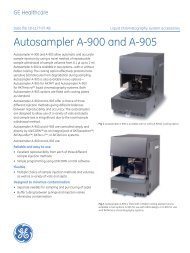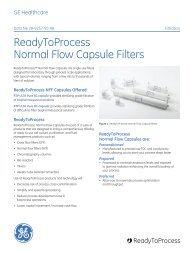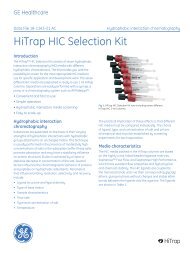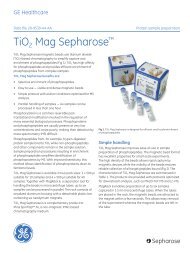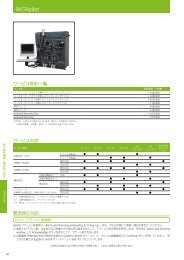Ni Sepharose™ High Performance HisTrap™ HP - GE Healthcare ...
Ni Sepharose™ High Performance HisTrap™ HP - GE Healthcare ...
Ni Sepharose™ High Performance HisTrap™ HP - GE Healthcare ...
Create successful ePaper yourself
Turn your PDF publications into a flip-book with our unique Google optimized e-Paper software.
<strong>GE</strong> <strong>Healthcare</strong><br />
Data file 18-1174-40 AE<br />
Tagged protein purification<br />
<strong>Ni</strong> Sepharose <strong>High</strong> <strong>Performance</strong><br />
HisTrap <strong>HP</strong><br />
The preparative purification of histidine-tagged<br />
recombinant proteins by immobilized metal affinity<br />
chromatography (IMAC) is both popular and highly effective.<br />
IMAC exploits the ability of the amino acid histidine to bind<br />
chelated transition metal ions. Histidine is globally the most<br />
used tag, often found as six histidine residues in series,<br />
but it is also present on the surface of many unmodified<br />
proteins. Of the metal ions used in this technique, nickel<br />
(<strong>Ni</strong> 2+ ) has generally been proven to be the most successful.<br />
<strong>Ni</strong> Sepharose <strong>High</strong> <strong>Performance</strong> further increases the use<br />
and reliability of this valuable method of purification.<br />
<strong>Ni</strong> Sepharose <strong>High</strong> <strong>Performance</strong> offers:<br />
• Negligible leakage of the <strong>Ni</strong> 2+ ion<br />
• Compatibility with a very wide range of reducing agents,<br />
detergents and other additives<br />
• Very high protein binding capacities<br />
• Convenient and time-saving prepacked HiTrap format in<br />
the form of HisTrap <strong>HP</strong> 1 ml and 5 ml columns<br />
These features make <strong>Ni</strong> Sepharose <strong>High</strong> <strong>Performance</strong><br />
the first-choice medium for the single-step purification of<br />
histidine-tagged recombinant proteins from cellular or cellfree<br />
systems.<br />
Chromatography medium characteristics<br />
<strong>Ni</strong> Sepharose <strong>High</strong> <strong>Performance</strong> consists of highly crosslinked<br />
6% agarose beads to which a chelating group has<br />
been immobilized. This chelating group has then been<br />
charged with <strong>Ni</strong> 2+ ions. The resulting medium selectively<br />
retains histidine-tagged recombinant proteins, allowing<br />
them to be purified from cellular contaminants or cell-free<br />
systems.<br />
Fig 1. <strong>Ni</strong> Sepharose <strong>High</strong> <strong>Performance</strong>, also prepacked as convenient<br />
HisTrap <strong>HP</strong> columns, is the first choice for purifying histidine-tagged<br />
recombinant proteins.<br />
The 34 µm bead Sepharose <strong>High</strong> <strong>Performance</strong> matrix with<br />
the chelating ligand immobilized displays high chemical<br />
and physical stability, resulting in excellent flow rates<br />
and distinctly separated peaks containing concentrated<br />
material.<br />
In addition, the chelating group charged with <strong>Ni</strong> 2+ gives a<br />
binding capacity that is demonstrably superior to similar<br />
media from other manufacturers.<br />
<strong>Ni</strong> Sepharose <strong>High</strong> <strong>Performance</strong> is compatible with all<br />
commonly used aqueous buffers, reducing agents and<br />
denaturants such as 6 M guanidine hydrochloride and 8 M<br />
urea, as well as a range of other additives. It is stable over a<br />
broad pH range. This high stability and broad compatibility<br />
maintains the biological activity and increases the yield of<br />
the purified product, at the same time as it greatly expands<br />
the range of suitable operating conditions, including<br />
procedures used to clean the medium. Table 1 lists the main<br />
characteristics of <strong>Ni</strong> Sepharose <strong>High</strong> <strong>Performance</strong>.<br />
imagination at work
Table 1. Main characteristics of <strong>Ni</strong> Sepharose <strong>High</strong> <strong>Performance</strong><br />
Matrix<br />
Mean particle size 34 µm<br />
Metal ion capacity<br />
Dynamic binding capacity 1<br />
Recommended flow rate 2<br />
Max back pressure<br />
Compatibility during use<br />
Chemical stability<br />
(<strong>Ni</strong> 2+ -stripped medium)<br />
Operation<br />
Packing in laboratory columns<br />
<strong>High</strong>ly cross-linked spherical<br />
agarose, 6%<br />
~15 µmol <strong>Ni</strong> 2+ /ml medium<br />
At least 40 mg (histidine) 6<br />
-tagged<br />
protein/ml medium<br />
Negligible nickel leakage<br />
The ability of <strong>Ni</strong> Sepharose <strong>High</strong> <strong>Performance</strong> to bind and<br />
hold nickel ions has been thoroughly tested by, for example,<br />
charging the matrix with <strong>Ni</strong> 2+ and then exposing it to harsh<br />
acidic conditions (pH 4.0). The amount of nickel ‘stripped-off’<br />
by this treatment was calculated as the ratio between the<br />
amount charged and that still bound.<br />
Results show very low leakage over the wide interval of<br />
nickel capacities screened, a clear testimony that the<br />
synthesis and coupling procedures used when manufacturing<br />
<strong>Ni</strong> Sepharose <strong>High</strong> <strong>Performance</strong> give a highly<br />
homogeneous chelating ligand. Furthermore, when nickel<br />
leakage from similar media was compared with that<br />
of <strong>Ni</strong> Sepharose <strong>High</strong> <strong>Performance</strong> using the same test<br />
method, it was found to be considerably higher (Table 3).<br />
Table 3. <strong>Ni</strong> Sepharose <strong>High</strong> <strong>Performance</strong> has a much lower nickel leakage<br />
compared to similar media tested<br />
Medium<br />
<strong>Ni</strong> 2+ leakage<br />
<strong>Ni</strong> Sepharose <strong>High</strong> <strong>Performance</strong> < 5%<br />
<strong>Ni</strong>-NTA Superflow 1 Average 2 9%<br />
1<br />
Details of all comparisons between <strong>Ni</strong> Sepharose <strong>High</strong> <strong>Performance</strong> and <strong>Ni</strong>-NTA<br />
Superflow described in this Data File are found at www.gehealthcare.com/protocol-his.<br />
All experiments were performed at <strong>GE</strong> <strong>Healthcare</strong>, Protein Separations’ laboratories.<br />
2<br />
Batch-to-batch variation was observed.<br />
<strong>Ni</strong> 2+ leakage was also compared in the presence of reducing<br />
agents such as 2 mM and 5 mM DTT, 5 mM TCEP, and 20 mM<br />
b-mercaptoethanol. In this case, leakage from <strong>Ni</strong> Sepharose<br />
<strong>High</strong> <strong>Performance</strong> was extremely low, up to ten-fold lower<br />
than from media supplied by other manufacturers. Figure<br />
2 shows <strong>Ni</strong> 2+ leakage from the compared media under<br />
reducing conditions.<br />
Summary<br />
The negligible nickel leakage from <strong>Ni</strong> Sepharose <strong>High</strong><br />
<strong>Performance</strong> helps retain the activity of the purified protein<br />
and reduce its precipitation, which results in increased<br />
purity, activity and yield of the target histidine-tagged protein.<br />
Leakage<br />
(µmol <strong>Ni</strong>/ml<br />
medium)<br />
3<br />
2<br />
1<br />
0<br />
Ref. 2 mM DTT 5mM DTT 5mM TCEP 20 mM ß-ME<br />
(binding buffer)<br />
<strong>High</strong> stability and compatibility<br />
= <strong>Ni</strong> Sepharose<br />
<strong>High</strong> <strong>Performance</strong><br />
= <strong>Ni</strong>-NTA Superflow<br />
Fig 2. Leakage of <strong>Ni</strong>2+ from <strong>Ni</strong> Sepharose <strong>High</strong> <strong>Performance</strong> under<br />
reducing conditions (60 column volumes, CV) is negligible compared with<br />
<strong>Ni</strong>-NTA Superflow.<br />
The wide interest in purifying histidine-tagged recombinant<br />
proteins makes medium stability and compatibility a key<br />
issue. Extensive studies have proven that <strong>Ni</strong> Sepharose <strong>High</strong><br />
<strong>Performance</strong> is outstanding in both respects. For example,<br />
the medium is stable with reducing agents such as DTT and<br />
DTE at concentrations up to 5 mM in sample and buffers.<br />
Chromatographic and SDS-PA<strong>GE</strong> analyses also reveal that<br />
protein separations are not negatively affected by various<br />
reducing agents. The same purity and recovery were<br />
achieved as for reference purification without any reducing<br />
agents added (Fig 3). For best results run a blank run before<br />
applying samples and buffers including reducing agents.<br />
Unlike similar media from other suppliers, the color of <strong>Ni</strong><br />
Sepharose <strong>High</strong> <strong>Performance</strong> is essentially unaltered by low<br />
concentrations of reducing agents such as DTT.<br />
M r<br />
97 000<br />
66 000<br />
45 000<br />
30 000<br />
20 100<br />
14 400<br />
LMW 1 2 3 4<br />
2 mM DTT 5 mM DTT<br />
M r<br />
97 000<br />
66 000<br />
45 000<br />
30 000<br />
20 100<br />
14 400<br />
repeated<br />
runs with<br />
DTT without<br />
<strong>Ni</strong> 2— recharging<br />
Fig 3. Reducing agents do not affect the purity or recovery of separation runs on <strong>Ni</strong> Sepharose <strong>High</strong> <strong>Performance</strong>.<br />
LMW<br />
20 mM<br />
ß-ME<br />
5 mM<br />
DTE<br />
10 mM<br />
Red. Glut<br />
Ref.<br />
5 mM<br />
TCEP<br />
mAU<br />
16000<br />
14000<br />
12000<br />
10000<br />
8000<br />
6000<br />
4000<br />
2000<br />
0<br />
1 mM DTE<br />
20 mM ß-mercaptoethanol<br />
Reference<br />
5 mM DTE<br />
5 mM TCEP<br />
10 mM red Glutathione<br />
0.0 10.0 20.0 30.0 40.0 ml<br />
03/2009 18-1174-40 AE 3
mg bound protein/<br />
ml medium<br />
60<br />
Table 4. <strong>Ni</strong> Sepharose <strong>High</strong> <strong>Performance</strong> is stable in the following<br />
reducing and denaturing agents, at least at the concentrations shown<br />
50<br />
40<br />
30<br />
20<br />
10<br />
0<br />
<strong>Ni</strong>-NTA <strong>Ni</strong> Sepharose <strong>Ni</strong>-NTA <strong>Ni</strong> Sepharose<br />
Superflow <strong>High</strong> <strong>Performance</strong> Superflow <strong>High</strong> <strong>Performance</strong><br />
= GFP-(His) 6<br />
= MBP-(His) 6<br />
5 mM DTE 1<br />
5 mM DTT 1<br />
20 mM b-mercaptoethanol 1<br />
5 mM TCEP 1<br />
10 mM reduced glutathione 1<br />
8 M urea 2<br />
6 M guanidine hydrochloride 2<br />
1<br />
For best results, perform a blank run before including reducing agents in the sample/<br />
buffer. For details see the instructions 17-5027-68 and 71-5027-67.<br />
2<br />
Tested for one week at 40°C.<br />
Medium MBP-(His) 6<br />
GFP-(His) 6<br />
mg/ml medium mg/ml medium<br />
<strong>Ni</strong> Sepharose <strong>High</strong> <strong>Performance</strong> 10 59<br />
<strong>Ni</strong>-NTA Superflow 1 0 9<br />
1<br />
Further details of this comparison can be found at www.gehealthcare.com/protocol-his<br />
Fig 4. <strong>Ni</strong> Sepharose <strong>High</strong> <strong>Performance</strong> has higher dynamic binding<br />
capacity (QB 10%<br />
) for histidine-tagged maltose binding protein, MBP-(His) 6<br />
,<br />
and histidine-tagged green fluorescent protein, GFP-(His) 6<br />
, in the presence<br />
of 8 M urea compared with <strong>Ni</strong>-NTA Superflow. Note that binding capacity<br />
is dependent on the protein.<br />
Figure 4 shows that <strong>Ni</strong> Sepharose <strong>High</strong> <strong>Performance</strong><br />
maintains its characteristically high dynamic binding<br />
capacity in the presence of 8 M urea, a strong denaturing<br />
agent (see later for native conditions). Note that <strong>Ni</strong>-NTA<br />
Superflow failed to match this performance.<br />
Table 4 summarizes the stability of <strong>Ni</strong> Sepharose <strong>High</strong><br />
<strong>Performance</strong> in common reducing and denaturing agents.<br />
Little, if any change is seen in protein purity or recovery<br />
when additives or a range of buffer substances are used.<br />
Table 5 summarizes the compatibility of <strong>Ni</strong> Sepharose<br />
<strong>High</strong> <strong>Performance</strong> with compounds commonly used in the<br />
purification of histidine-tagged proteins.<br />
In most IMAC applications, imidazole is used for elution<br />
and, at lower concentrations, to increase the selectivity<br />
for histidine-tagged proteins. It is well known that the<br />
binding of untagged contaminants is suppressed with<br />
imidazole, and that too high a concentration of imidazole<br />
will also prevent binding of histidine-tagged proteins. The<br />
concentration of imidazole that will give optimal purification<br />
results (in terms of purity and yield) is protein-dependent,<br />
and is usually slightly higher for <strong>Ni</strong> Sepharose <strong>High</strong><br />
<strong>Performance</strong> than for similar IMAC media on the market.<br />
Finding the optimal imidazole concentration for a histidinetagged<br />
protein is a trial-and-error effort, but 20–40 mM<br />
in the sample and the binding and wash buffers is a good<br />
starting point for many proteins.<br />
Figure 5 presents a typical purification of a histidinetagged<br />
protein expressed in E. coli. For clarity, only the<br />
gradient parts of the chromatograms are shown. The pool<br />
eluted from <strong>Ni</strong> Sepharose <strong>High</strong> <strong>Performance</strong> has a much<br />
higher protein concentration than that eluted from <strong>Ni</strong>-NTA<br />
Superflow. Also note that the amount of nickel ion in the<br />
eluted fractions is lower in the fractions pooled from <strong>Ni</strong><br />
Sepharose <strong>High</strong> <strong>Performance</strong>, which confirms the low nickel<br />
leakage from this medium seen in other studies.<br />
The low nickel content, in combination with the high<br />
concentration of the target protein in the eluted pool from<br />
<strong>Ni</strong> Sepharose <strong>High</strong> <strong>Performance</strong>, results in a molar ratio<br />
<strong>Ni</strong> 2+ /protein that in this case is over two-fold lower than<br />
<strong>Ni</strong>-NTA Superflow. In some cases, this can be very important<br />
for preventing precipitation of the target protein.<br />
Table 5. <strong>Ni</strong> Sepharose <strong>High</strong> <strong>Performance</strong> is compatible with the<br />
following detergents, additives, and buffer substances, at least at the<br />
concentrations shown<br />
2% Triton X-100 (nonionic detergent)<br />
2% Tween 20 (nonionic detergent)<br />
2% NP-40 (nonionic detergent)<br />
2% cholate (anionic detergent)<br />
1% CHAPS (zwitterionic detergent)<br />
500 mM imidazole<br />
20% ethanol<br />
50% glycerol<br />
100 mM Na 2<br />
SO 4<br />
1.5 M NaCl<br />
1 mM EDTA 1<br />
60 mM citrate 1<br />
50 mM sodium phosphate, pH 7.4<br />
100 mM Tris-HCl, pH 7.4<br />
100 mM Tris-acetate, pH 7.4<br />
100 mM HEPES, pH 7.4<br />
100 mM MOPS, pH 7.4<br />
100 mM sodium acetate, pH 4 2<br />
1<br />
The strong chelator EDTA has been used successfully at 1 mM. Generally, chelating<br />
agents should be used with caution (and only in the sample, not the buffer). Any<br />
metal-ion stripping may be counteracted by addition of a small excess of MgCl 2<br />
before<br />
centrifugation/filtration of the sample. Note that stripping effects may vary with applied<br />
sample volume.<br />
2<br />
Tested for one week at 40°C.<br />
4 03/2009 18-1174-40 AE
Column: 1) HisTrap <strong>HP</strong> 1 ml<br />
2) 1 ml column, dimensions (i.d. × h) 5 mm × 5 cm<br />
Media: 1) <strong>Ni</strong> Sepharose <strong>High</strong> <strong>Performance</strong><br />
2) <strong>Ni</strong>-NTA Superflow<br />
Sample: 12 mg histidine-tagged green fluorescent protein, GFP-(His) 6<br />
,<br />
E. coli extract<br />
Sample volume: 19 ml (clarified extract)<br />
Binding buffer: 20 mM sodium phosphate, 500 mM NaCl, 5 mM imidazole, pH 7.4<br />
Elution buffer: 20 mM sodium phosphate, 500 mM NaCl,<br />
500 M imidazole, pH 7.4<br />
Gradient: 25 ml linear gradient of 5 to 250 mM imidazole, followed<br />
by a ”push” with 500 mM imidazole<br />
1. HisTrap <strong>HP</strong><br />
Column volume: 0.25 ml, dimensions (i.d. × h), 5 mm × 1.3 cm<br />
Medium: 1) <strong>Ni</strong> Sepharose <strong>High</strong> <strong>Performance</strong>. 2) <strong>Ni</strong>-NTA Superflow<br />
Sample: Pure histidine-tagged maltose binding protein,<br />
MBP-(His) 6<br />
, M r<br />
43 000, 1 mg/ml<br />
Flow rate: 0.25 ml/min<br />
Binding buffer: 20 mM sodium phosphate, 5 mM imidazole, 500 mM NaCl, pH 7.4<br />
Elution buffer: 20 mM sodium phosphate, 500 mM imidazole, 500 mM NaCl, pH 7.4<br />
A<br />
mAU<br />
2000<br />
1500<br />
<strong>Ni</strong> Sepharose <strong>High</strong> <strong>Performance</strong><br />
Approx. binding 65 mg/ml medium<br />
A 280 nm<br />
A 490 nm<br />
mAU<br />
mAU<br />
1000<br />
2500<br />
2500<br />
2000<br />
2000<br />
500<br />
1500<br />
1500<br />
0<br />
1000<br />
1000<br />
0 20.0 40.0 60.0 80.0 Column volumes<br />
(CV)<br />
500<br />
0<br />
pool<br />
50.0 55.0 60.0 65.0 70.0 75.0 80.0 ml<br />
2. <strong>Ni</strong>-NTA Superflow<br />
500<br />
0<br />
B<br />
mAU<br />
2000<br />
1500<br />
<strong>Ni</strong>-NTA Superflow<br />
Approx. binding 14 mg/ml medium<br />
A 280 nm<br />
mAU<br />
2500<br />
2000<br />
1500<br />
1000<br />
500<br />
0<br />
pool<br />
50.0 55.0 60.0 65.0 70.0 75.0 80.0 ml<br />
A 490 nm<br />
mAU<br />
2500<br />
2000<br />
1500<br />
1000<br />
500<br />
0<br />
1000<br />
500<br />
0<br />
0 20.0 40.0 60.0 80.0 Column volumes<br />
(CV)<br />
Fig 6. <strong>Ni</strong> Sepharose <strong>High</strong> <strong>Performance</strong> has a greater dynamic binding<br />
capacity (seen here as time of binding) for MBP-(His) 6<br />
than <strong>Ni</strong>-NTA<br />
Superflow. The areas of the elution peaks cannot be compared since the<br />
highest absorbance signals are above the linear range.<br />
Summary<br />
Lane<br />
1. LMW markers<br />
2. Eluted pool, HisTrap <strong>HP</strong><br />
3. Eluted pool, <strong>Ni</strong>-NTA Superflow<br />
4. Eluted pool, HisTrap <strong>HP</strong>, dil. 1:4<br />
5. Eluted pool, <strong>Ni</strong>-NTA Superflow, dil. 1:4<br />
Pooled fractions from: µg <strong>Ni</strong> 2+ /l Protein conc. Molar ratio<br />
(ppb) (mg/ml) <strong>Ni</strong> 2+ /protein<br />
1) HisTrap <strong>HP</strong> 185 1.60 0.055<br />
2) <strong>Ni</strong>-NTA Superflow 231 0.91 0.121<br />
Fig 5. Protein concentration is higher and nickel leakage lower in pooled<br />
fractions from <strong>Ni</strong> Sepharose <strong>High</strong> <strong>Performance</strong> during linear gradient<br />
elution. Final protein purity was similar in both runs (black arrows indicate<br />
the final pools). For SDS-PA<strong>GE</strong>, pools were adjusted to the same volume<br />
to obtain equal intensity of target protein bands. This was confirmed by<br />
the 1:4 dilutions. The peak areas are not comparable since the highest<br />
absorbance signals are above the linear range.<br />
The overall high chemical stability of <strong>Ni</strong> Sepharose <strong>High</strong><br />
<strong>Performance</strong> also applies to the medium in its HisTrap <strong>HP</strong><br />
column formats. As well as helping maintain biological<br />
activity and increasing product yield, it greatly expands the<br />
range of conditions in which the medium can be used.<br />
<strong>High</strong> protein binding capacity for more<br />
efficient purifications<br />
The dynamic binding capacity of <strong>Ni</strong> Sepharose <strong>High</strong><br />
<strong>Performance</strong> has been evaluated with pure histidinetagged<br />
maltose binding protein, MBP-(His) 6<br />
, (M r<br />
43 000) and<br />
with pure green fluorescent protein, GFP-(His) 6<br />
, (M r<br />
28 000),<br />
using the parameter 10% breakthrough (QB 10%<br />
).<br />
The absorbance at 280 nm is measured for a pure protein<br />
solution. The solution is then continuously loaded on the<br />
column and the absorbance of the eluate is followed until<br />
breakthrough occurs, that is, the column starts to saturate.<br />
The volume of protein solution (or milligram protein) that<br />
has been applied up to a certain breakthrough point (for<br />
example, QB 10%<br />
) is a measure of the dynamic protein binding<br />
capacity of the medium (protein is then eluted after a wash).<br />
Comparative chromatograms (Fig 6) demonstrate that <strong>Ni</strong><br />
Sepharose <strong>High</strong> <strong>Performance</strong> binds 1 mg/ml MBP-(His) 6<br />
for<br />
a considerably longer period (Approx. 70 column volumes)<br />
03/2009 18-1174-40 AE 5
mg bound<br />
protein/ml<br />
medium<br />
80<br />
70<br />
60<br />
50<br />
40<br />
30<br />
20<br />
10<br />
0<br />
<strong>Ni</strong>-NTA <strong>Ni</strong>-NTA <strong>Ni</strong> Sepharose <strong>Ni</strong> Sepharose<br />
Superflow Superflow <strong>High</strong> <strong>Performance</strong> <strong>High</strong> <strong>Performance</strong><br />
(Room temperature) (+4ºC) (Room temperature) (+4ºC)<br />
Columns: 1. HisTrap <strong>HP</strong> 1 ml<br />
2. <strong>Ni</strong>-NTA Superflow 1 ml<br />
3. His-Select 1 ml<br />
Sample: GFP-(His) 6<br />
, 1.85 mg/ml (including 5 mM imidazole)<br />
in E. coli extract<br />
Sample volume: 32 ml clarified extract<br />
Flow rate: 1 ml/min<br />
Binding buffer: 20 mM sodium phosphate, 500 mM NaCl,<br />
5 mM imidazole, pH 7.4<br />
Elution buffer: 20 mM sodium phosphate, 500 mM NaCl,<br />
500 mM imidazole, pH 7.4<br />
Gradient: 25 ml linear gradient, 5 to 250 mM imidazole<br />
A 490 nm<br />
mAU<br />
Medium<br />
MBP-(His) 6<br />
mg/ml medium<br />
<strong>Ni</strong> Sepharose <strong>High</strong> <strong>Performance</strong>:<br />
Room temp. 68<br />
4°C 67<br />
<strong>Ni</strong>-NTA Superflow:<br />
Room temp. 13<br />
4°C 8<br />
Fig 7. Dynamic binding capacity data (QB 10%<br />
) for <strong>Ni</strong> Sepharose <strong>High</strong><br />
<strong>Performance</strong> determined for MBP-(His) 6<br />
exceeds that of <strong>Ni</strong>-NTA Superflow<br />
at room temperature and 4°C. Note that binding capacity will vary from<br />
protein to protein and at different temperatures.<br />
than <strong>Ni</strong>-NTA Superflow (approx. 20 column volumes)<br />
before the protein elutes from the column, that is before<br />
breakthrough has occurred. The determined dynamic<br />
binding capacity of <strong>Ni</strong> Sepharose <strong>High</strong> <strong>Performance</strong> is<br />
65 mg/ml medium, which greatly exceeds that of <strong>Ni</strong>-NTA<br />
Superflow (14 mg/ml medium).<br />
Figure 7 shows protein binding capacity data determined at<br />
room temperature and 4°C. Once again, <strong>Ni</strong> Sepharose <strong>High</strong><br />
<strong>Performance</strong> outperforms <strong>Ni</strong>-NTA Superflow.<br />
Figure 8 presents further evidence of the excellent protein<br />
binding capacity of <strong>Ni</strong> Sepharose <strong>High</strong> <strong>Performance</strong><br />
compared with other media. Using a cell extract containing<br />
GFP-(His) 6<br />
as the target protein, the yield for HisTrap <strong>HP</strong><br />
1 ml was about two times higher than <strong>Ni</strong>-NTA Superflow<br />
and over three times higher than His-Select. SDS-PA<strong>GE</strong> of<br />
equal volumes of the eluted peaks confirms the result (Fig 9)<br />
Summary<br />
The high binding capacity of <strong>Ni</strong> Sepharose <strong>High</strong><br />
<strong>Performance</strong> means greater efficiency. More sample can<br />
be applied and a concentrated target protein is obtained at<br />
lower cost per milligram in a shorter time..<br />
1500<br />
1000<br />
500<br />
0<br />
0.0 20.0<br />
40.0 60.0<br />
80.0 ml<br />
Lane<br />
1. LMW markers<br />
2. Start material, GFP-(His) 6<br />
3. Eluted pool, HisTrap <strong>HP</strong><br />
4. Eluted pool, <strong>Ni</strong>-NTA Superflow<br />
5. Eluted pool, His-Select<br />
= HisTrap <strong>HP</strong><br />
= <strong>Ni</strong>-NTA Superflow<br />
= His-Select<br />
Fig 8. The binding capacity of <strong>Ni</strong> Sepharose <strong>High</strong> <strong>Performance</strong> for GFP-<br />
(His) 6<br />
compared with two other media. Note the differences in loss of GFP-<br />
(His) 6<br />
during sample application and differences in area of eluted peaks.<br />
Details of the comparison between <strong>Ni</strong> Sepharose <strong>High</strong> <strong>Performance</strong>,<br />
<strong>Ni</strong>-NTA Superflow, and His-Select are found at www.gehealthcare.com/<br />
protocol-his. This experiment was performed at <strong>GE</strong> <strong>Healthcare</strong>, Protein<br />
Separations’ laboratories.<br />
Fig 9. SDS-PA<strong>GE</strong> analysis of GFP-(His) 6<br />
recovered in equal volumes of eluted<br />
peaks confirms the protein binding result seen in Figure 8. Improved purity<br />
can be achieved by increasing the imidazole concentration.<br />
6 03/2009 18-1174-40 AE
A<br />
B<br />
C<br />
Fig 10. Using HisTrap <strong>HP</strong> 1 ml with a syringe. A) Prepare buffers and sample. Remove the column’s top cap and snap-off the end. Wash and equilibrate.<br />
B) Load the sample and begin collecting fractions. C) Wash and elute, continue collecting fractions.<br />
Speed, convenience, and increased<br />
reproducibility<br />
<strong>Ni</strong> Sepharose <strong>High</strong> <strong>Performance</strong> is easy to pack and use in<br />
laboratory columns such as Tricorn and XK columns. HisTrap<br />
<strong>HP</strong> prepacked columns, however, maximize time-saving and<br />
increase ease-of-use of <strong>Ni</strong> Sepharose <strong>High</strong> <strong>Performance</strong>.<br />
HisTrap <strong>HP</strong> 1 ml and 5 ml columns<br />
HisTrap <strong>HP</strong> 1 ml and 5 ml columns permit rapid yet reliable<br />
separations with the minimum of preparation and<br />
equipment. Figure 10 illustrates a purification with a syringe,<br />
for which connectors are supplied with each column.<br />
HisTrap <strong>HP</strong> can also be operated with a simple laboratory<br />
pump by following a similar procedure.<br />
Prepacked columns also mean consistently high quality<br />
and, above all, greatly increased reproducibility. This<br />
reproducibility is best achieved in practice by running the<br />
columns on ÄKTA design chromatography systems, which<br />
include pre-programmed method templates for HisTrap <strong>HP</strong><br />
columns. Method templates cover common techniques such<br />
as single-step purifications of histidine-tagged recombinant<br />
proteins, and allow many user-defined protocols to be<br />
stored. Simply snap the HisTrap <strong>HP</strong> column into place and<br />
start purifying.<br />
Scaling up<br />
HisTrap <strong>HP</strong> columns are also simple to scale up for syringe,<br />
pump or system-based use. To increase capacity, just<br />
connect two or three 1 ml or 5 ml columns in series. Note,<br />
however, that the backpressure will increase (<strong>Ni</strong> Sepharose<br />
<strong>High</strong> <strong>Performance</strong> packed in laboratory columns from the<br />
Tricorn or XK series offers an equally reliable alternative).<br />
Summary<br />
HisTrap <strong>HP</strong> columns package all the performance benefits<br />
of <strong>Ni</strong> Sepharose <strong>High</strong> <strong>Performance</strong> in a highly attractive<br />
format. Their convenience and ease-of-use translate the<br />
inherent advantages of histidine-tagged recombinant<br />
protein purification into a simple and reliable everyday<br />
laboratory tool.<br />
Acknowledgements<br />
MBP-(His) 6<br />
was provided by Phadia, Uppsala, Sweden. GFP-<br />
(His) 6<br />
was provided by Dr. David Drew, Dept. of Biochemistry<br />
and Biophysics, Stockholm University, Stockholm, Sweden.<br />
03/2009 18-1174-40 AE 7
Ordering Information<br />
Products Quantity Code No.<br />
<strong>Ni</strong> Sepharose <strong>High</strong> <strong>Performance</strong> 25 ml 2 17-5268-01<br />
100 ml 2 17-5268-02<br />
5 × 1 ml 17-5247-01<br />
HisTrap <strong>HP</strong> 1 100 × 1 ml 3 17-5247-05<br />
1 × 5 ml 17-5248-01<br />
5 × 5 ml 17-5248-02<br />
100 × 5 ml 3 17-5248-05<br />
1<br />
Includes connectors for easy connection to syringe, pump, or chromatography system.<br />
2<br />
Larger quantities are available.<br />
3<br />
Pack size available by special order.<br />
Related products Quantity Code No.<br />
HiTrap Desalting 5 × 5 ml 17-1408-01<br />
100 × 5 ml 1 11-0003-29<br />
HiPrep 26/10 Desalting 1 × 53 ml 17-5087-01<br />
4 × 53 ml 17-5087-02<br />
1<br />
Pack size available by special order.<br />
Empty lab-scale columns Quantity Code No.<br />
Tricorn 5/20 column 1 18-1163-08<br />
Tricorn 5/50 column 1 18-1163-09<br />
Tricorn 10/20 column 1 18-1163-13<br />
Tricorn 10/50 column 1 18-1163-14<br />
Tricorn 10/100 column 1 18-1163-15<br />
XK 16/20 column 1 18-8773-01<br />
XK 16/40 column 1 18-8774-01<br />
XK 26/20 column 1 18-1000-72<br />
XK 26/40 column 1 18-8768-01<br />
Accessories No. Supplied Code No.<br />
1/16” male/luer female 1 2 18-1112-51<br />
Tubing connector flangeless/M6 female 1 2 18-1003-68<br />
Tubing connector flangeless/M6 male 1 2 18-1017-98<br />
Union 1/16” female/M6 male 1 6 18-1112-57<br />
Union M6 female /1/16” male 1 5 18-3858-01<br />
Union luerlock female/M6 female 2 18-1027-12<br />
HiTrap/HiPrep, 1/16” male connector 8 28-4010-81<br />
for ÄKTA design<br />
Stop plug female, 1/16” 2 5 11-0004-64<br />
Fingertight stop plug, 1/16” 3 5 11-0003-55<br />
1<br />
One connector included in each HiTrap/HisTrap package.<br />
2<br />
Two, fi ve, or seven stop plugs female included in HiTrap/HisTrap packages depending on<br />
the product.<br />
3<br />
One fingertight stop plug is connected to the top of each HiTrap/HisTrap column.<br />
Related literature Quantity Code No.<br />
Recombinant Protein Handbook,<br />
Principles and Methods 1 18-1142-75<br />
Affinity Chromatography Handbook,<br />
Principles and Methods 1 18-1022-29<br />
Affinity Chromatography Columns and 1 18-1121-86<br />
Media, Selection Guide<br />
<strong>Ni</strong> Sepharose and IMAC Sepharose,<br />
Selection Guide 1 28-4070-92<br />
HiTrap Column Guide 1 18-1129-81<br />
Prepacked chromatography columns for<br />
ÄKTA design systems 1 29-9317-78<br />
For local office contact information, visit<br />
www.gelifesciences.com/contact<br />
<strong>GE</strong> <strong>Healthcare</strong> Bio-Sciences AB<br />
Björkgatan 30<br />
751 84 Uppsala<br />
Sweden<br />
www.gelifesciences.com/protein-purification<br />
imagination at work<br />
<strong>GE</strong>, imagination at work and <strong>GE</strong> monogram are trademarks of<br />
General Electric Company.<br />
HisTrap, HiTrap, HiPrep, ÄKTA, Sepharose, Tricorn, and Drop Design<br />
are trademarks of <strong>GE</strong> <strong>Healthcare</strong> companies.<br />
The Tricorn column and components are protected by US design<br />
patents USD500856, USD506261, USD500555, USD495060 and their<br />
equivalents in other countries.<br />
<strong>Ni</strong> Sepharose products are covered by US patent number 6 623 655<br />
and equivalent patents and patent applications in other countries.<br />
Purification and preparation of fusion proteins and affinity peptides<br />
comprising at least two adjacent histidine residues may require<br />
a license under US pat 5,284,933 and US pat 5,310,663, including<br />
corresponding foreign patents (assigne: Hoffman La Roche, Inc).<br />
All third party trademarks are the property of their respective<br />
owners.<br />
© 2005–2009 General Electric Company – All rights reserved.<br />
First published 2005.<br />
All goods and services are sold subject to the terms and conditions<br />
of sale of the company within <strong>GE</strong> <strong>Healthcare</strong> which supplies them. A<br />
copy of these terms and conditions is available on request. Contact<br />
your local<br />
<strong>GE</strong> <strong>Healthcare</strong> representative for the most current information.<br />
<strong>GE</strong> <strong>Healthcare</strong> Europe GmbH<br />
Munzinger Strasse 5<br />
D-79111 Freiburg<br />
Germany<br />
<strong>GE</strong> <strong>Healthcare</strong> UK Ltd<br />
Amersham Place<br />
Little Chalfont<br />
Buckinghamshire, <strong>HP</strong>7 9NA<br />
UK<br />
<strong>GE</strong> <strong>Healthcare</strong> Bio-Sciences Corp<br />
800 Centennial Avenue, P.O. Box 1327<br />
Piscataway, NJ 08855-1327<br />
USA<br />
<strong>GE</strong> <strong>Healthcare</strong> Bio-Sciences KK<br />
Sanken Bldg. 3-25-1, Hyakunincho<br />
Shinjuku-ku, Tokyo 169-0073<br />
Japan<br />
18-1174-40 AE 03/2009



![[PDF] マニュアル GradiFrac](https://img.yumpu.com/22037825/1/190x253/pdf-gradifrac.jpg?quality=85)
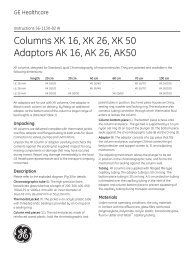
![[PDF] Sample preparation for analysis of protein, peptides and ...](https://img.yumpu.com/21549715/1/190x257/pdf-sample-preparation-for-analysis-of-protein-peptides-and-.jpg?quality=85)
![[PDF] Data File: rProtein A Sepharose Fast Flow](https://img.yumpu.com/21549316/1/190x253/pdf-data-file-rprotein-a-sepharose-fast-flow.jpg?quality=85)
![[PDF] MBP-tagged protein purification](https://img.yumpu.com/21548507/1/184x260/pdf-mbp-tagged-protein-purification.jpg?quality=85)
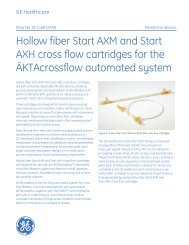
![[PDF] AKTA ready system Data file](https://img.yumpu.com/21540925/1/190x253/pdf-akta-ready-system-data-file.jpg?quality=85)
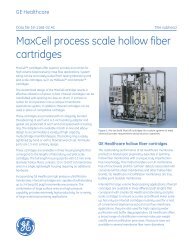
![[PDF] Data File - rProtein A/Protein G GraviTrap](https://img.yumpu.com/21539052/1/190x253/pdf-data-file-rprotein-a-protein-g-gravitrap.jpg?quality=85)
